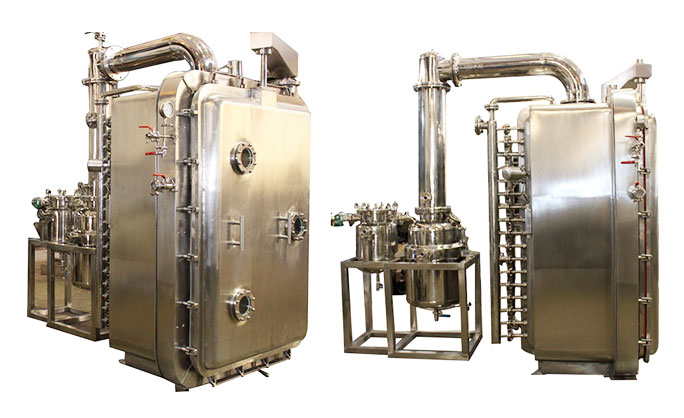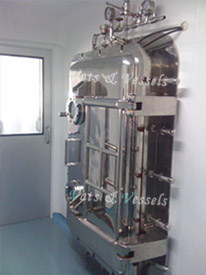Products Range
Vacuum Shelf Dryer (Tray Dryer)
Many a times, in the chemical process industries, we are faced with difficulties in drying materials due to high toxic contents, hygroscopic in nature, heat sensitive.

SS 316 cGMP 24 TRAY VACUUM SHELF DRYER
Installed at : EMBIO LTD., MAHAD, MAHARASHTRA, INDIA.

To solve the above problems, vacuum dryers are used where the boiling point of the materials to be dried is brought down and the entire system is in a closed loop. No contamination occurs, due to the closed arrangement. Any vapours evolved during the drying process is cooled down through a connected Heat Exchanger and collected in a reciever The Vacuum Shelf Dryer when combined with a solvent extraction system, ensures that almost all of the evaporating vapours is recovered and condensed in to a reciever which is vacuumised.
Working Principle of Vacuum Shelf Dryer
The Vacuum Shelf Dryer is basically a tray dryer working under vacuum conditions. It dries on the conduction principle. There are a number of shelves inside the dryer on which the product laden trays are placed. The top most shelf is a dummy shelf to ensure proper heating and to block dried powder from escaping into the solvent extraction system.
The shelves are manufactured in hollow construction with baffles cum stiffeners placed in between. Each shelf has an inlet and outlet nozzle. Each shelf is connected through these nozzles to an Inlet and Outlet Header. Hot media is passed through the Inlet Header and in turn to each shelf. The hot media flows through the shelves in a serpentine fashion ensuring faster heat transfer to the surface, which in turn heats up the Trays placed on the shelves. The hot media flows out from the shelves through the Outlet Header.
The Inlet and Outlet Headers are designed such that the flow of the heating media is equally distributed into the each of the shelves.
The Dryer chamber is constructed from heavy thickness plates to ensure that there is no buckling during the vacuum operation. Additional limpet coils are provided to further stiffen the body and also to pass the hot media. The chamber is provided with a heavy door with a adequate locking arrangement.
The Dryer Chamber is connected through a vapour column to a Shell & Tube type Heat Exchanger, which in turn is connected to a Condenstate Receiver. Vacuum is applied to the condensate receiver. Vapour evolved during the drying process is collected in the receiver after it is cooled in the Heat Exchanger.
The vapour to be cooled is passed through the tube side of the Heat Exchanger. While cooling water is passed through the shell side. A cooling coil is present in the condensate reciever, to further cool any vapours entering the reciever before it is goes into the vacuum pump.
The Condensate Reciever is connected to a Vacuum Trap, to ensure that any uncooled vapours arising from the reciever is trapped and allowing very minimal contents of the vapour to pass into the Vacuum Pump.
Salient Features of the Vacuum Shelf Dryer (tray Dryer)
- All corners of drying chamber including door rounded to ensure cGMP standards
- Standard features include Dryer Chamber with Vapour Extraction system & Heating Arrangement
- 4 Point Temperature Scanner
- Single Point Control for all pumps & Controllers
- Compact Skid arrangement for all Auxillary Equipments
- Designed such that all auxillary equipments can be placed in utility area, ensuring huge cost savings incurred for setting up & running clean room area.
- FLP model available on request